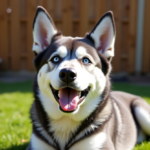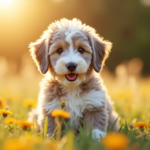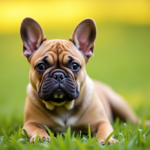The Cavalier King Charles Spaniel is a small and friendly dog. It enjoys great popularity among many families around the world. They are known for their large, round eyes and silky fur; they are gentle and affectionate, and people enjoy being around them. These dogs are easy to train. She is good with children, and she is also good with other animals. Their history dates back to the royal family. Because they were once the favorites of kings and queens in England. Today, they are creating wonderful companions for those who want a loyal and loving pet.
Caring for a Cavalier King Charles Spaniel is not very difficult. But this requires regular care, exercise, and attention to their health. They need daily outings and playtime to be happy. Their beautiful fur also needs to be brushed several times a week. Although they are generally healthy, Cavalier dogs may face some health issues, so it is essential to visit the vet regularly. Whether you live in a small apartment or a large house, this adaptable dog will fit in perfectly as always. As long as he receives love and attention from his family.
Quick Facts About Cavalier King Charles Spaniels
- Breed Name: Cavalier King Charles Spaniel
- Size: Small
- Weight: 13-18 pounds (6-8 kg)
- Height: 12-13 inches (30-33 cm)
- Lifespan: 12-15 years
- Coat: Medium-length, silky, requires regular brushing
- Colors: Blenheim (chestnut and white), Tricolor, Black and Tan, Ruby
- Temperament: Affectionate, friendly, gentle, and social
- Exercise Needs: Moderate; 30-60 minutes of activity daily
- Training: Easy to train, eager to please
- Good with Kids: Yes, very patient and gentle with children
- Good with Other Pets: Yes, gets along well with other dogs and cats
- Common Health Issues: Mitral Valve Disease (MVD), Syringomyelia (SM), Hip Dysplasia, Patellar Luxation, Ear Infections, Eye Problems
- Best Living Environment: Adaptable to apartments or houses, but needs companionship
- Grooming: Needs brushing 3-4 times a week, regular ear cleaning
- Personality: Loving, loyal, and very attached to their owners
- Origin: United Kingdom
- History: Bred for royalty, favorite of King Charles II
- AKC Group: Toy Group
History of the Cavalier King Charles Spaniel
The Cavalier King Charles Spaniel has an interesting and royal history that stretches back several centuries. Named after King Charles II of England, this breed was a favorite among the nobility. In fact, King Charles II was so fond of these dogs that they followed him wherever he went. The breed was depicted in many royal paintings of the time, often sitting by their owner’s side.
Before King Charles II, toy spaniels were already popular with European royalty. These early dogs were smaller versions of the spaniel, bred for companionship rather than hunting. They were often seen in the courts of France and England, where they were pampered pets of the aristocracy.
However, during the reign of William III and Mary II, the flat-faced Pug became more popular, and the traditional “Cavalier” spaniel style began to fade. It wasn’t until the early 20th century that efforts were made to bring back the original look of these spaniels, leading to the creation of the Cavalier King Charles Spaniel we know today.
Appearance of the Cavalier King Charles Spaniel
The Cavalier King Charles Spaniel is a small dog, with a refined yet sturdy build. They usually weigh between 13 to 18 pounds and stand around 12 to 13 inches tall. Despite their small size, they are graceful and elegant.
Their coat is one of their most striking features. It is silky, with feathering on the ears, chest, legs, and tail. They come in four distinct color patterns:
- Blenheim – Chestnut markings on a white background, often with a distinctive “blenheim spot” on the forehead.
- Tricolor – Black and white with tan markings on the eyes, cheeks, and tail.
- Ruby – A solid rich red coat.
- Black and Tan – Shiny black with tan markings similar to the tricolor pattern.
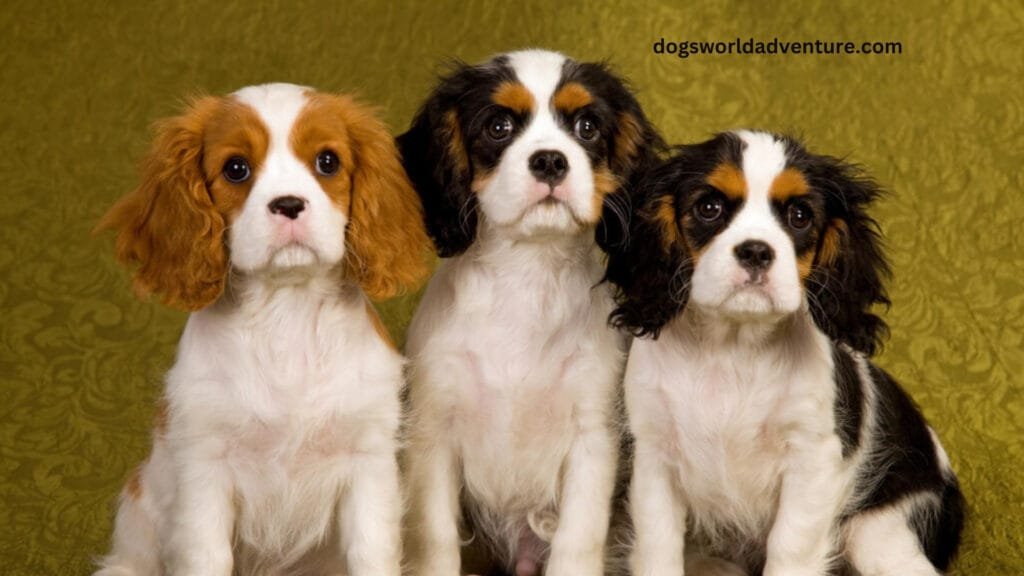
The Cavalier’s large, round eyes are perhaps their most endearing feature. Their expression is gentle and loving, often melting the hearts of anyone who meets them.
Temperament of the Cavalier King Charles Spaniel
The Cavalier King Charles Spaniel is known for its friendly and affectionate personality. These dogs are incredibly social and love being around people. They thrive on attention and are happiest when they are near their family. Cavaliers, as they are often called, are gentle and kind, making them excellent companions for children, seniors, and even other pets.
These dogs are naturally playful and enjoy games like fetch or chasing a ball. However, they are also just as happy curling up on the couch for a long nap. Their adaptable nature makes them suitable for various lifestyles, whether you live in a city apartment or a house with a large yard.
Cavaliers are often described as “lap dogs” because of their love for cuddling. They bond closely with their families and enjoy being a constant companion, whether you’re watching TV, reading a book, or just relaxing.
Why the Cavalier King Charles Spaniel is a Great Family Dog
The Cavalier King Charles Spaniel is an ideal family dog for several reasons. First, their gentle nature makes them safe around children. They are patient and tolerant, which is important in households with young kids. However, it’s important to teach children how to interact with dogs properly, ensuring both the dog and the child are happy and safe.
Second, their adaptability means they can adjust to different living situations. Whether you live in a small apartment or a large home, as long as they get enough attention and exercise, the Cavalier King Charles Spaniel will be content. They are also great for families with multiple pets, as they tend to get along well with other animals.
Lastly, their friendly nature extends beyond their immediate family. They are usually warm and welcoming to strangers, making them poor watchdogs but excellent companions.
Exercise Needs of the Cavalier King Charles Spaniel
Despite their small size, the Cavalier King Charles Spaniel is a relatively active dog. They enjoy outdoor activities, such as walking, playing, or even hiking. It’s essential to ensure your Cavalier gets enough exercise to prevent boredom, which can lead to destructive behaviors.
Ideally, the Cavalier should get about 30 to 60 minutes of exercise each day. This could be in the form of a walk around the neighborhood, playtime in the yard, or even some indoor games. Cavaliers love to chase balls, play with toys, and engage in interactive games with their owners.
While they are energetic outdoors, they also know how to relax indoors. Cavaliers are equally happy curling up next to you on the couch after a good play session. This balance of energy and calm makes them a great choice for families with varying levels of activity.
Grooming and Care for the Cavalier King Charles Spaniel
The Cavalier King Charles Spaniel’s beautiful, silky coat requires regular grooming to keep it looking its best. Brushing their coat at least three to four times a week is recommended to prevent tangles and mats. During shedding season, you may need to brush them more often to remove loose hair.
Aside from brushing, regular ear cleaning is essential for this breed. Their long, floppy ears can trap moisture and debris, which can lead to ear infections if not cleaned regularly. Use a gentle ear cleaner and cotton balls to keep their ears clean and dry.
Cavaliers are also prone to dental issues, so it’s important to brush their teeth regularly. Aim to brush your dog’s teeth at least two to three times a week to prevent plaque buildup and other dental problems.
Regular nail trims are another part of your Cavalier’s grooming routine. Trim their nails every few weeks to keep them from becoming too long and causing discomfort.
Health Concerns for the Cavalier King Charles Spaniel
Like many purebred dogs, the Cavalier King Charles Spaniel has a few health concerns that p
1. Mitral Valve Disease (MVD)
Mitral Valve Disease is one of the most common health problems in Cavalier King Charles Spaniels. It affects the heart and occurs when the valve between the heart’s chambers doesn’t close properly, causing blood to leak backward. Over time, this can lead to heart failure if not treated. MVD is often seen in older Cavaliers, but some may develop it at a younger age. Regular vet check-ups and heart screenings can help catch MVD early and allow for better management.
2. Syringomyelia (SM)
Syringomyelia is a serious condition that affects the brain and spine of Cavalier King Charles Spaniels. It occurs when the skull is too small for the brain, causing pressure and fluid-filled cavities to form in the spinal cord. This can lead to symptoms like pain, scratching at the air, or difficulty walking. While Syringomyelia can be managed with medication, more severe cases might require surgery. Since this condition is genetic, it’s important to get your dog from a reputable breeder who screens for it.
3. Hip Dysplasia
Although more common in larger breeds, hip dysplasia can also affect Cavalier King Charles Spaniels. This condition occurs when the hip joint doesn’t fit properly into the socket, leading to pain, stiffness, and even arthritis over time. Signs of hip dysplasia include difficulty getting up, limping, or reluctance to jump or climb stairs. Maintaining a healthy weight and providing regular exercise can help reduce the risk of this condition. In more severe cases, surgery may be needed.
4. Patellar Luxation
Patellar luxation, or a dislocated kneecap, is another common issue in Cavaliers. This happens when the kneecap slips out of place, causing pain and difficulty walking. In mild cases, the kneecap may pop back into place on its own, but more severe cases might require surgery. Signs of patellar luxation include skipping or hopping while walking and sudden lameness.
5. Ear Infections
Cavalier King Charles Spaniels have long, floppy ears, which can trap moisture and lead to ear infections. Regular ear cleaning is important to prevent infections caused by bacteria or yeast. Signs of an ear infection include head shaking, scratching at the ears, and a bad odor coming from the ears. If left untreated, ear infections can become chronic and cause more serious problems.
6. Eye Problems
Cavaliers are also prone to certain eye problems, including cataracts, dry eye (keratoconjunctivitis sicca), and retinal problems. Dry eye occurs when the dog’s eyes don’t produce enough tears, leading to irritation and discomfort. Cataracts, which cause cloudiness in the lens of the eye, can lead to vision problems or blindness. Regular vet visits and eye exams can help catch these issues early and prevent long-term damage.
7. Obesity
While not a genetic issue, obesity is a common problem for Cavalier King Charles Spaniels, as they tend to love food and can become overweight if overfed. Obesity can lead to other health issues like heart disease, diabetes, and joint problems. Keeping your Cavalier at a healthy weight through proper diet and regular exercise is essential for their overall well-being.
Feeding Your Cavalier King Charles Spaniel
Feeding your Cavalier King Charles Spaniel a balanced diet is essential for maintaining their health and well-being. Most Cavaliers do well on high-quality commercial dog food, but it’s important to choose food that is specifically formulated for small breeds.
Cavaliers should be fed around 1 to 1.5 cups of food per day, split into two meals. The exact amount will depend on your dog’s size, age, activity level, and metabolism. Be careful not to overfeed your Cavalier, as they can easily gain weight, which can lead to other health issues like joint problems and diabetes.
Fresh water should always be available, and you should avoid giving your Cavalier table scraps or human food, as this can lead to obesity and other health problems.
Training a Cavalier King Charles Spaniel
Training a Cavalier King Charles Spaniel is usually an enjoyable experience because they are eager to please and intelligent. They respond well to positive reinforcement, which means rewarding them with treats, praise, or playtime when they do something right.
It’s important to start training your Cavalier as early as possible. Basic commands like “sit,” “stay,” and “come” should be taught when they are puppies. Cavaliers are sensitive dogs, so it’s essential to use gentle training methods. Harsh training can cause them to become fearful or anxious.
Socialization is also key for a well-behaved Cavalier. Expose them to different people, environments, and other animals while they are young to ensure they grow into well-adjusted adults.
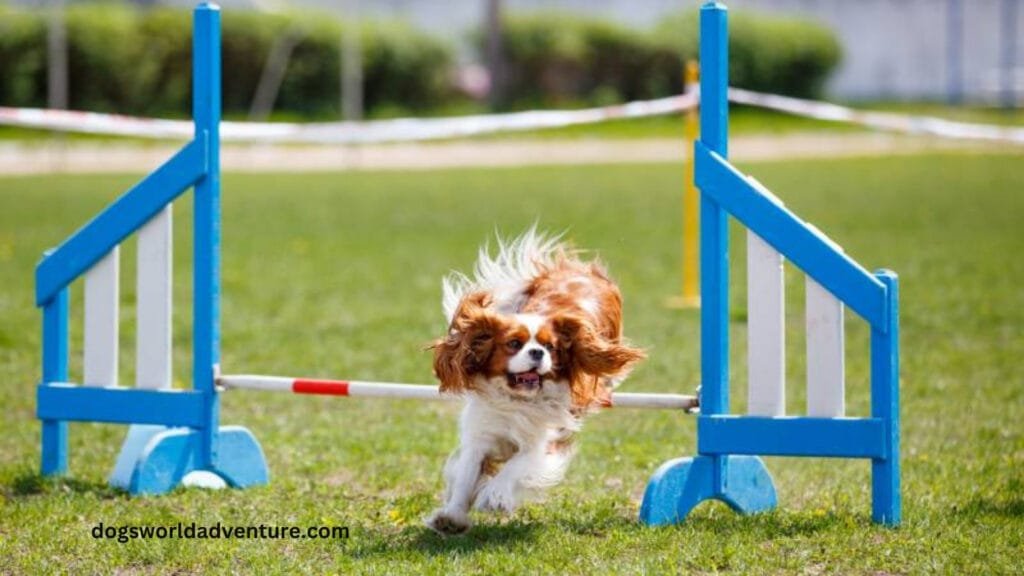
Crate training can also be useful for Cavaliers. It provides them with a safe space to retreat when they need some quiet time and can also help with housebreaking.
Socializing Your Cavalier King Charles Spaniel
Cavaliers are naturally friendly and social dogs, but early socialization is important to help them grow into well-rounded adults. Introducing your puppy to various people, places, sounds, and experiences can help prevent them from becoming shy or anxious as they grow older.
Taking your Cavalier to dog parks, enrolling them in puppy classes, or simply inviting friends over can help with socialization. These experiences teach your dog how to behave around others and give them confidence in new situations.
Are Cavalier King Charles Spaniels Good Family Dogs?
Yes, the Cavalier King Charles Spaniel is a fantastic family dog. Their gentle, friendly, and affectionate nature makes them perfect companions for families of all sizes. These dogs are known for their patience, which is why they do so well with children. They are neither overly hyper nor too aloof, striking a nice balance between being playful and calm. This breed is highly adaptable and can fit in with families that lead both active and more laid-back lifestyles.
Because they are small and not overly energetic, Cavaliers can live comfortably in both apartments and larger homes. As long as they get their daily exercise and attention, they’re perfectly happy. However, Cavaliers do not do well when left alone for long periods. They crave human companionship, and their emotional well-being depends on spending time with their family. If left alone too often, they might develop separation anxiety, which can lead to destructive behavior.
Cavalier King Charles Spaniels and Other Pets
The Cavalier King Charles Spaniel is a social dog that typically gets along well with other pets. Whether you have other dogs or even cats, Cavaliers can be excellent companions for multi-pet households. Their friendly and non-aggressive nature means they usually don’t have trouble adjusting to other animals in the home.
Early socialization is key to ensuring your Cavalier grows up comfortable around other animals. Introducing your puppy to other pets at a young age will make them more relaxed and accepting of their furry companions. Supervised playtime and gradual introductions can help ensure peaceful coexistence.
Training Tips for Cavalier King Charles Spaniels
Training a Cavalier King Charles Spaniel is usually an enjoyable process due to their intelligence and eagerness to please. Cavaliers respond best to positive reinforcement, such as treats, praise, and affection. They are sensitive dogs, so it’s important to avoid harsh methods. Gentle encouragement will lead to better results.
Start with basic commands like “sit,” “stay,” and “come.” Short, fun training sessions are the best approach since Cavaliers can sometimes get distracted or bored with longer sessions. Early training will help establish good behavior and make sure your Cavalier grows into a well-behaved adult.
One of the most important aspects of training a Cavalier is housebreaking. These dogs are usually quick learners, but like any puppy, they will need consistent routines to learn where and when to go to the bathroom. Crate training is also an effective method for helping Cavaliers feel safe and secure while also making housebreaking easier.
Travel Tips for Cavalier King Charles Spaniel Owners
Cavaliers love being close to their families, which means they generally enjoy traveling with their owners. Whether you’re going on a road trip or flying to a new destination, Cavaliers adapt well to travel, as long as their needs are met.
When traveling by car, it’s essential to keep your Cavalier secure. Use a pet seatbelt or crate to ensure their safety. Cavaliers enjoy being with you, so leaving them alone in the car for extended periods can make them anxious. Always provide water, bathroom breaks, and a cozy space for them during long journeys.
If you’re flying with your Cavalier, make sure to check the airline’s pet policy in advance. Because Cavaliers are small, they can often travel in the cabin with you in an airline-approved carrier. This is preferable to cargo travel, as Cavaliers are sensitive and may not do well when separated from their owner.
The Lifespan of a Cavalier King Charles Spaniel
The average lifespan of a Cavalier King Charles Spaniel is between 12 to 15 years. With proper care, many Cavaliers live long, healthy lives. Ensuring they have a balanced diet, regular exercise, and routine veterinary care will help extend their lifespan and keep them feeling their best.
One of the best ways to promote longevity in your Cavalier is by staying proactive about their health. Regular vet visits can help detect potential problems early, and a healthy diet combined with sufficient exercise can keep them in peak condition.
Common Misconceptions About the Cavalier King Charles Spaniel
One common misconception about the Cavalier King Charles Spaniel is that they are high-maintenance due to their royal history. While their coat does require regular grooming, Cavaliers are relatively easy to care for in comparison to some other small dog breeds. Their affectionate and friendly nature often makes them a low-stress pet to own.
Another misconception is that Cavaliers are overly dependent. While they do enjoy the company of their family and don’t like being left alone for long periods, they are also capable of spending some quiet time by themselves, especially if they have been crate-trained and given enough physical and mental stimulation throughout the day.
Finally, some people think that because Cavaliers are small, they don’t need much exercise. While it’s true they don’t need the same amount of exercise as larger breeds, they still require daily walks and playtime to stay healthy. Cavaliers have a playful side that needs to be engaged regularly.
Cavalier King Charles Spaniel’s Role in Modern Culture
In modern times, the Cavalier King Charles Spaniel has gained popularity not only as a beloved family pet but also as a celebrity dog. Many famous individuals, from actors to musicians, have chosen Cavaliers as their pet of choice. Their adorable appearance and lovable personalities have made them a staple in pop culture. You’ll often see them featured in movies, TV shows, and even on social media as influencers in their own right!
This breed’s connection to royalty has also carried into the modern age. Their regal history gives them an air of sophistication that appeals to many people. Despite their royal lineage, Cavaliers remain down-to-earth and approachable, making them popular with people from all walks of life.
Preparing for a Cavalier King Charles Spaniel Puppy
If you’re thinking about bringing a Cavalier King Charles Spaniel puppy into your home, there are a few things you need to prepare. First, make sure your home is puppy-proofed. Remove any hazardous items that your puppy might chew on, such as electrical cords, toxic plants, or small objects they could swallow.
Next, set up a comfortable space for your new puppy to sleep. This could be a crate or a cozy dog bed. Puppies need a safe, quiet area where they can rest and feel secure.
You’ll also need to gather the essentials, such as a collar, leash, food and water bowls, toys, grooming supplies, and high-quality puppy food. Puppies are full of energy and will benefit from having toys to play with and chew on.
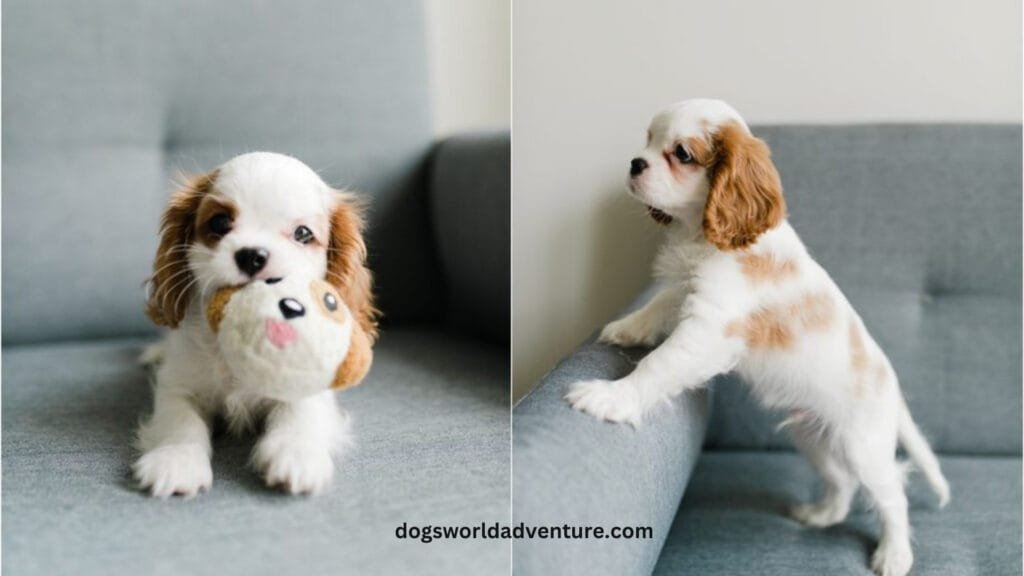
Finally, make sure to schedule a vet appointment soon after bringing your new puppy home. The vet will give your puppy a health check and start them on a vaccination schedule to ensure they grow into a healthy adult.
Conclusion
The Cavalier King Charles Spaniel is truly one of the most beloved dog breeds in the world. With their charming appearance, affectionate personality, and friendly nature, they make the perfect companion for both individuals and families. Whether you’re looking for a playful pet to keep your children entertained or a loyal friend to share your quiet moments, the Cavalier King Charles Spaniel can be an ideal match. With proper care, training, and attention, your Cavalier will bring joy and companionship for many years to come.
FAQs
1. How much exercise does a Cavalier King Charles Spaniel need?
Cavaliers need about 30 to 60 minutes of exercise each day. This could include walks, playtime, or other outdoor activities.
2. Are Cavalier King Charles Spaniels good with children?
Yes, they are gentle and patient dogs, making them excellent companions for families with children.
3. How often should I groom my Cavalier King Charles Spaniel?
You should brush your Cavalier’s coat three to four times a week to prevent tangles and mats. Regular ear cleaning, teeth brushing, and nail trimming are also important.
4. What health issues are common in Cavalier King Charles Spaniels?
Common health issues include Mitral Valve Disease (MVD), syringomyelia, hip dysplasia, and eye problems.
5. Can Cavalier King Charles Spaniels live in apartments?
Yes, they adapt well to apartment living as long as they get enough exercise and attention.
6. How long do Cavalier King Charles Spaniels live?
They typically live between 12 to 15 years with proper care.
7. Do Cavalier King Charles Spaniels shed a lot?
Yes, they do shed moderately, and regular brushing can help manage the shedding.
8. Are Cavalier King Charles Spaniels easy to train?
Yes, they are intelligent and eager to please, making them relatively easy to train with positive reinforcement.
9. Do Cavaliers get along with other pets?
Yes, they are friendly and social dogs that usually get along well with other pets, including cats and other dogs.
10. Can I leave my Cavalier King Charles Spaniel alone for long periods?
No, Cavaliers do not do well when left alone for long periods. They are social dogs and need plenty of companionship.



